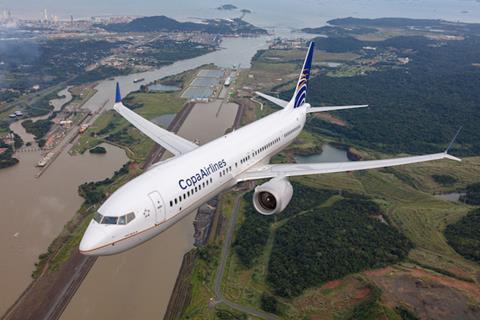Copa Airlines expects the robust travel demand and profits it saw last year to continue through 2024, even as its growth takes a hit from the Boeing 737 Max 9 grounding.
“[We] continue to see a healthy demand environment in the region and expect to once again deliver strong operating margins in 2024,” Copa Holdings chief executive Pedro Heilbron said during the airline company’s fourth-quarter earnings call on 8 February.
The group forecasts a 21-23% operating margin this year.
Copa earned a $219 million operating profit in the fourth quarter, with a 24% operating margin. Its fourth-quarter operating revenue increased 3% year on year to $917 million, while its operating expenses jumped 4% year on year to $698 million in the period.
Copa’s fourth-quarter cost growth was partially offset by lower fuel and distribution expenses, the latter thanks to an increase in direct-to-consumer sales. The carrier turned a fourth-quarter net profit of $192 million.
Copa’s full-year 2023 operating revenue increased 17% year on year, to $3.5 billion, while its costs increased 5.4% year on year to $2.6 billion.
“2023 was a very strong year for Copa,” says Heilbron.

While its 2024 financial outlook remains positive, Copa has parred back its expected capacity growth following the 737 Max 9 grounding in January. It anticipates its available seat miles (ASMs) will increase only about 10% this year, down from a previously predicted 12-14% increase.
Copa expects to be “fully and fairly compensated” by Boeing for the grounding, says chief financial officer Jose Montero.
Corporate travel demand remains depressed from pre-pandemic levels, but travellers visiting friends and relatives, and leisure traffic, are exceeding the pre-Covid-19 benchmark.
The impact of unrest in Ecuador on Copa’s outlook is not “significant,” Heilbron adds.
Slower growth is not stopping Copa from expanding its map and strategic Panama City hub. It plans to add Florianopolis in Brazil, Raleigh-Durham in North Carolina, and Tulum in Mexico to its network this summer. Heilbron describes Raleigh-Durham, which serves the capital of North Carolina, as a rapidly growing Southeast US city that Copa does not “serve really well today.”
Copa stands to be the only Latin American airline flying to Raleigh-Durham when its flights begin in June. Aeromexico will join it less than a month later with its own nonstop to Mexico City. Lufthansa also plans to add service to the airport this summer.
Raleigh-Durham is a focus city for Delta Air Lines, which is a partner of Aeromexico.
Copa’s expansion plans come after it grew capacity, as measured in available seat miles (ASMs), by 13.4% last year. That included the addition of Austin, Baltimore-Washington, Barquisimeto in Venezuela, and Manta in Ecuador to its map. Its low-cost subsidiary Wingo also added several new domestic routes in Colombia and Panama.
Heilbron describes Panama City as the “most complete and convenient connecting hub in Latin America”.
SLOWER FLEET GROWTH
Copa has cut four 737 Max from its 2024 fleet plan as a result of the Max 9 grounding, Montero says. It expects further delivery delays to 11 aircraft due this year. The carrier’s 2024 fleet plan now includes its first eight Max 8s, as well as three Max 9s.
“It’s going to be a difficult year in terms of additional capacity or having planes available,” Heilbron says.
Boeing’s 737 production rates are capped at 38 per month as the US Federal Aviation Administration audits its production processes on the Max line.
Copa has Japanese-operating-lease-with-call-option financing in place for eight of its 11 planned Max deliveries this year, Montero says. The structure allows an airline to finance the full capital cost of aircraft.


























